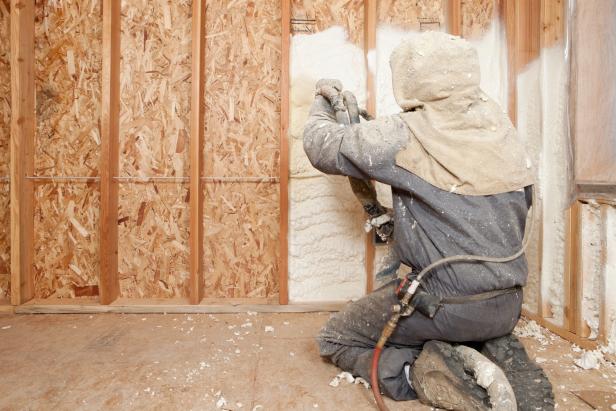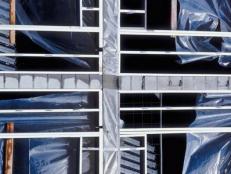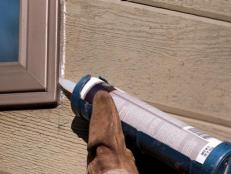Installing Spray Foam Insulation to Boost Your Home's Air Quality and Energy Efficiency
Improve your home's energy efficiency with spray foam insulation. Learn about the difference between open-cell and closed-cell, the cost of spray foam insulation and whether it's a good DIY project.

Many homes lack proper insulation and suffer from high utility bills as a result of energy inefficiency. It's simple science, really: The second law of thermodynamics states that heat flows in one direction, from a warm space to a cold one. So in the summer, heat tries to come inside, and in the winter, it tries to escape.

BanksPhotos
Any knowledgeable DIYer can learn how to install their own spray foam insulation during construction or remodel when a room is down to the studs. For most spaces, it's as easy as purchasing a kit.
That's why an under-insulated or uninsulated home has to work much harder to retain a consistent indoor temperature, but there are important steps every homeowner can take to optimize their home for comfort and performance. To build a better thermal envelope and maximize energy efficiency, it’s important to review all areas of the home and identify where heat can escape. An energy audit will help reveal weaknesses in a home's attic, floors and walls, and it will likely suggest better home insulation as a solution.
But what is home insulation? You probably picture traditional fiberglass batt insulation (the pink stuff). But while batt insulation can help prevent unwanted airflow, there's a better method for preventing heat loss — one that is easy to install and is within your budget: Spray foam insulation.
Benefits of Spray Foam Insulation
Did you know that the amount of heat that escapes from the average home every day could fill up a blimp? Consider spray foam insulation because it:
- Provides an air-tight seal, which in turn improves indoor air quality by minimizing the presence of mold spores and pollen in your living areas.
- Acts as a moisture barrier.
- Withstands extreme temperatures.
- Adds structural reinforcement to walls and floors.
- Lasts a lifetime.
Open-Cell vs. Closed Cell
There are two types of spray foam insulation that homeowners can use to insulate their homes: open-cell and closed-cell insulation. “When and where to use open or closed-cell foam is a fairly complex issue due to the possibility of trapping moisture in wall cavities or sealed spaces,” shares Traci Fournier, Vice President of Operations of One Hour Heating & Air Conditioning. While both open-cell foam and closed-cell foam can be installed as a DIY project, a homeowner might first consider consulting with an expert to get advice based on their space.
Open-Cell Foam
Open-cell is good to use for small, hard-to-reach areas, but it has a lower R-value and is less dense than closed-cell foam because it expands more. Its lighter qualities actually make it better for soundproofing, because the frequency waves are more easily trapped by the air structure of the foam. It works well for small applications, such as to reduce gaps around your electrical outlets, but not as well as closed-cell foam in exterior walls.
Closed-Cell Foam
Closed-cell expands less and has a much higher resistance making it ideal for use inside walls, in attic spaces and as crawl space insulation. It is resistant to water and moisture, unlike open-cell foam which allows it to prevent mold growth. It’s dense, and can even be used to reinforce a structure.

BanksPhotos
You can improve your home's insulation with spray foam at any time, but it's easiest to install during new construction or remodeling before drywall is added.
Can You Install Your Own Spray Foam Insulation?
When most people think of home insulation, their mind immediately goes to the common, pink fiberglass insulation batts that run between the studs and are stapled into place. While fiberglass is perceived as the easiest insulation for homeowners to install, it doesn’t create an airtight seal, so heat can still escape.
Fortunately, both closed- and open-cell spray foam insulation is just as easy to apply. We asked Foumier for her professional perspective, and she agreed: “Yes, homeowners can install their own spray form insulation. There are DIY spray foam insulation kits. Yes, it can be messy if not done properly. The good news is that overspray is fairly easy to remove from unfinished surfaces. Most consumer-grade kits do not require rental equipment."
An essential watch-out: While you can carefully apply spray foam around coated electrical wires, this insulation can be flammable. Avoid using it to insulate around an active electrical circuit or inside electrical boxes. Use light caps if you are installing spray foam on top of recessed lights in an attic.
Compare Pricing of Insulation
Fiberglass insulation is among the most affordable insulation products, at $1.25 per square foot. That said, considering the many benefits, homeowners are surprised to find that the cost of spray foam is not unreasonable. Measured as a board foot (one square foot x one inch thick), it costs $1.95 per square foot when you buy a convenient closed-cell spray foam insulation kit.
Open-cell spray foam is priced closer to $2.30 per square foot.
Pricing for professional installation can triple the price of any insulation project, making it truly advantageous to handle as a DIY project.

Spray foam insulation can be installed from the outside of a structure during an exterior remodel.
How to Apply Spray Foam
The best practice for insulating is to use spray foam insulation to fill the spaces between the framing studs in the walls and attic.
Here's how to insulate a large space with spray foam insulation.
- Start by doing a test spray. This material expands to about 100 times its initial volume, so test it conservatively until you understand how it fills in. Remember: Closed-cell spray foam must be one to two inches thick to achieve the desired R-value.
- Spray evenly between the studs and on the backside of the exterior sheathing. Allow it to expand so it fills all the gaps.
- Allow the foam to form and set.
- Shave away any foam that extends past the studs. Using a handsaw or blade, remove any raised foam so that it is flush with the studs. It will not compress and will become an obstacle when you're ready to install the drywall.
There are methods used by professionals to inject spray foam into a wall that is already covered by drywall, but the best and most thorough applications are possible when there is no interfering drywall. The best times to install spray foam insulation is during construction prior to drywall or if you are planning to re-drywall an entire room for the purpose of improving insulation.








































